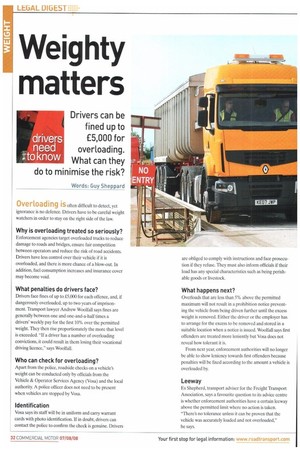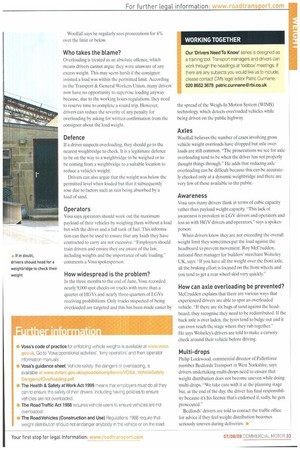Weighty matters
Page 32

Page 33

If you've noticed an error in this article please click here to report it so we can fix it.
Drivers can be fined up to £5,000 for overloading. What can they do to minimise the risk?
drivers need ;to know
Words: Guy Sheppard
Overloading is
__ often difficult to detect, yet ignorance is no defence. Drivers have to be careful weight watchers in order to stay on the right side of the law.
Why is overloading treated so seriously?
Enforcement agencies target overloaded trucks to reduce damage to roads and bridges, ensure fair competition between operators and reduce the risk of road accidents. Drivers have less control over their vehicle if it is overloaded, and there is more chance of a blow-out. In addition, fuel consumption increases and insurance cover may become void.
What penalties do drivers face?
Drivers face fines of up to /5,000 for each offence, and, if dangerously overloaded, up to two years of imprisonment. Transport lawyer Andrew Woolfall says fines are generally between one and one-and-a-half times a drivers' weekly pay for the first 10% over the permitted weight. They then rise proportionately the more that level is exceeded. "If a driver has a number of overloading convictions, it could result in them losing their vocational driving licence," says Woolfall.
Who can check for overloading?
Apart from the police, roadside checks on a vehicle's weight can be conducted only by officials from the Vehicle & Operator Services Agency (Vosa) and the local authority A police officer does not need to be present when vehicles are stopped by Vosa.
Identification
Vosa says its staff will be in uniform and carry warrant cards with photo identification. If in doubt, drivers can contact the police to confirm the check is genuine. Drivers are obliged to comply with instructions and face prosecution if they refuse. They must also inform officials if their load has any special characteristics such as being perishable goods or livestock.
What happens next?
Overloads that are less than 5% above the permitted maximum will not result in a prohibition notice preventing the vehicle from being driven further until the excess weight is removed. Either the driver or the employer has to arrange for the excess to be removed and stored in a suitable location when a notice is issued. Woolfall says first offenders are treated more leniently but Vosa does not reveal how tolerant it is.
From next year, enforcement authorities will no longer be able to show leniency towards first offenders because penalties will be fixed according to the amount a vehicle is overloaded by.
Leeway
Es Shepherd, transport adviser for the Freight Transport Association, says a favourite question to its advice centre is whether enforcement authorities have a certain leeway above the permitted limit where no action is taken. "There's no tolerance unless it can be proven that the vehicle was accurately loaded and not overloaded," he says. Woolfall says he regularly sees prosecutions for 4% over the limit or below.
Who takes the blame?
Overloading is treated as an absolute offence, which means drivers cannot argue they were unaware of any excess weight. This may seem harsh if the consignor insisted a load was within the permitted limit. According to the Transport & General Workers Union, many drivers now have no opportunity to supervise loading anyway because, due to the working hours regulations, they need to reserve time to complete a round trip. However, drivers can reduce the severity of any penalty for overloading by asking for written confirmation from the consignor about the load weight.
Defence
If a driver suspects overloading, they should go to the nearest weighbridge to check. It is a legitimate defence to be on the way to a weighbridge to be weighed or to be coming from a weighbridge to a suitable location to reduce a vehicle's weight.
Drivers can also argue that the weight was below the permitted level when loaded but that it subsequently rose due to factors such as rain being absorbed by a load of sand,
Operators Vosa says operators should work out the maximum payload of their vehicles by weighing them without a load but with the driver and a full tank of fuel. This information can then be used to ensure that any loads they have contracted to carry are not excessive. "Employers should train drivers and ensure they are aware of the law. including weights and the importance of safe loading,comments a Vosa spokesperson.
How widespread is the problem? In the three months to the end of June, Vosa recorded nearly 9,000 spot checks on trucks with more than a quarter of HGVs and nearly three-quarters of LGVs receiving prohibitions. Only trucks suspected of being overloaded are targeted and this has been made easier by
the spread of the Weigh-In Motion System (WIMS) technology, which detects overloaded vehicles while being driven on the public highway.
Axles Woolfall believes the number of cases involving gross vehicle weight overloads have dropped but axle overloads are still common. "The prosecutions we see for axle overloading tend to be when the driver has not properly thought things through." He adds that reducing axle overloading can be difficult because this can be accurately checked only at a dynamic weighbridge and there are very few of these available to the public.
Awareness
Vosa says many drivers think in terms of cubic capacity rather than payload weight capacity. "This lack of awareness is prevalent in LGV drivers and operators and less so with HGV drivers and operators," says a spokesperson.
When drivers know they are not exceeding the overall weight limit they sometimes put the load against the headboard to prevent movement. Roy McCrudden, national fleet manager for builders' merchant Wolseley UK, says: "If you have all the weight over the front axle, all the braking effort is focused on the front wheels and you tend to get a rear wheel skid very quickly."
How can axle overloading be prevented? McCrudden explains that there are various ways that experienced drivers are able to spot an overloaded vehicle. "If there are six bags of sand against the headboard, they recognise they need to be redistributed. If the back axle is over laden, the tyres tend to bulge out and it can even reach the stage where they rub together." He says Wolseley's drivers are told to make a cursory check around their vehicle before driving.
Multi-drops
Philip Lockwood, commercial director of Palletforce member Bedfords Transport in West Yorkshire, says drivers undertaking multi-drops need to ensure that weight distribution does not become uneven while doing multi-drops. "We take care with it at the planning stage but, at the end of the day, the driver has final responsibility because it's his licence that's endorsed if, sadly, he gets prosecuted."
Bedfords' drivers are told to contact the traffic office for advice if they feel weight distribution becomes seriously uneven during deliveries. at


























































































































































